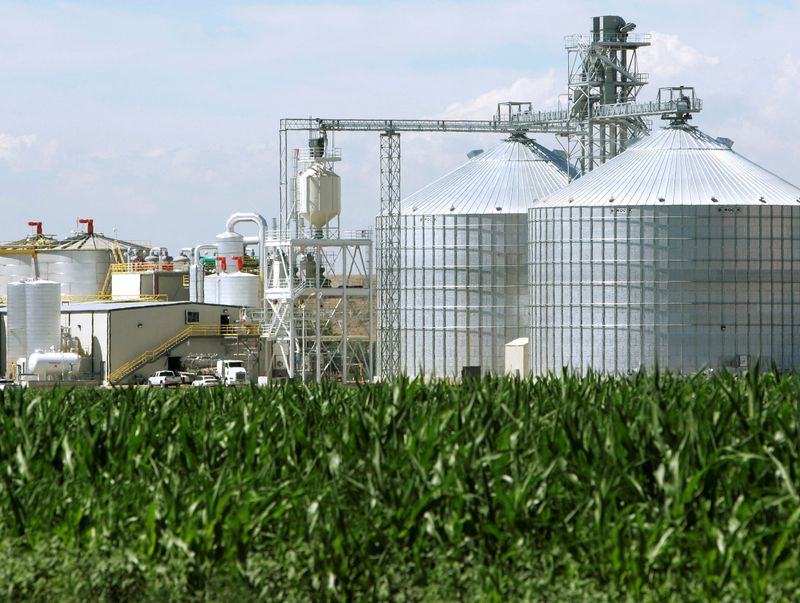By Jarrett Renshaw and Stephanie Kelly
(Reuters) - The Biden administration is considering lowering the 2022 ethanol blending mandate below the proposed 15 billion gallons amid backlash from the oil refining lobby and unions arguing the shrinking U.S. ethanol industry can no longer support the target, according to two sources familiar with the administration’s thinking.
U.S. President Joe Biden vowed to bring some normalcy back to laws requiring refiners to blend biofuels like corn-based ethanol into the nation’s gasoline pool after his predecessor, Donald Trump, took unprecedented steps to relieve refiners from the requirement.
But Biden is finding it difficult to live up to his promise. The COVID-19 pandemic has dampened fuel consumption and triggered a handful of ethanol plant shutdowns. Higher regulatory costs have refiners threatening to close refineries and shed high-paying union jobs.
In December, the Environmental Protection Agency issued a long-awaited biofuel blending mandate proposal that cut ethanol requirements for 2020 and 2021 but restored them to 15 billion gallons for 2022. Farmers and biofuel producers criticized the rollbacks but welcomed the restoration this year.
But, in recent weeks, administration officials have considered rolling back the 15 billion gallon mandate when the final rule is issued later this year, the two sources told Reuters.
"EPA remains committed to the growth of biofuels in America," said Nick Conger, an EPA spokesperson. "We look forward to reviewing the robust comments that we receive from all stakeholders before finalizing our rulemaking later this year."
The administration had initially planned to set the 2022 ethanol mandate at 14.1 billion gallons, Reuters previously reported https://www.reuters.com/business/energy/exclusive-us-epa-considering-cuts-biofuel-blending-obligations-2020-2021-2022-2021-09-22, but went with 15 billion gallons under pressure from Farm-Belt Democrats like Senator Tammy Duckworth of Illinois.
“The White House is caught between a rock and a hard place. On one hand, they want to support the agricultural and biofuel industry, but they have been bombarded by unions and refiners who say there’s not enough ethanol and they are listening,” said one of the sources familiar with the discussions.
Under the Renewable Fuel Standard, refiners must blend biofuels like ethanol into their fuel pool or buy tradable credits, known as RINs, from refiners who do. Merchant refiners like PBF Energy (NYSE:PBF) and Monroe Energy have long complained that the cost of purchasing RINs threatens their plants.
While cuts to the 2020 and 2021 ethanol mandate briefly lowered RIN costs, they have since rebounded. RINs are trading about 50% higher from the around 80 cents after the mandates were announced in December.
After Reuters reported the news on Wednesday, RIN prices fell about 6% to $1.20 each. Margins to produce gasoline fell to an intraday low of $17 per barrel, before recovering.
Mike Burnside, Policy Analyst at the American Fuel & Petrochemical Manufacturers, a leading refining trade group, told the EPA during a hearing on the blending mandate proposal that its 2022 targets are out of step with demand.
"EIA (the Energy Information Administration) projects that gasoline consumption in 2022 will be below 2019 demand, so it is unreasonable to propose 15 billion gallons for conventional biofuel in 2022 as if the pandemic never happened and we are back to normal," Burnside said.
ETHANOL PLANTS SHUT
The U.S. ethanol industry has seen a number of facilities shut down in the last few years, and the industry had to deal with reduced fuel demand because of the coronavirus pandemic. There were 197 U.S. ethanol plants at the beginning of 2021, down from 201 a year earlier, EIA data showed.
Some ethanol companies have strayed from production of the corn-based fuel.
For instance, a company formerly known as Pacific Ethanol (NASDAQ:ALTO) Inc said in 2020 it would change its name to reflect its focus on specialty alcohols used in beverages and sanitizers instead of fuel. It is now Alto Ingredients Inc.
"I don't see anyone running to invest more," said Ed Hirs, who teaches energy economics at the University of Houston.
Still, the ethanol industry enjoyed higher margins and increased production in the later half of 2021.
In November, margins to produce ethanol in the Corn Belt increased to $1.82 per gallon, the highest since 2014, Refinitiv Eikon data showed. They have since fallen to about 37 cents per gallon.

U.S. ethanol production in October rose to the most since 2017, according to the EIA.
"The administration has indicated blending requirements will remain strong and at 15 billion gallons for 2022, and we have every expectation that they will deliver on that promise," said Growth Energy Chief Executive Emily Skor, in response to the news on Wednesday.